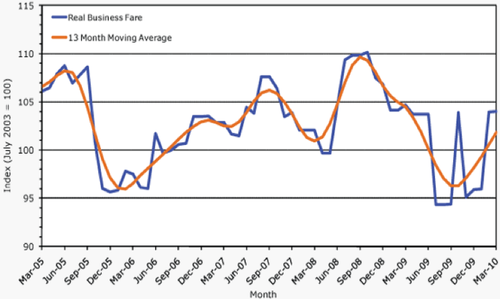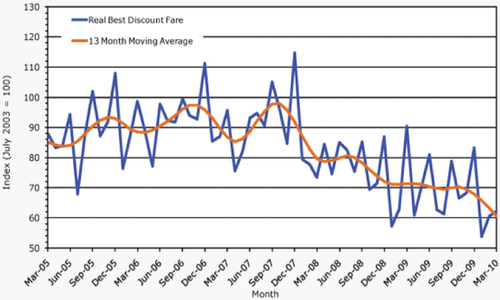Qantas yields heading in the right direction, but still weaker than 2008. Tiger traffic zooms
Qantas Group's traffic results for Jan-2010 revealed signs that yields are starting to improve after a very difficult 2009. Over the past two months, Qantas international yields have showed continued improvement, with monthly yields moving from a 10.3% year-on-year reduction in Dec-2009, to a 7.7% reduction in Jan-2010. This represents a notable improvement from CAPA-estimated yield reductions of 19.2% in Nov-2009 and 27.2% in Oct-2009. The improved yield figures were released just three weeks after the carrier reported a cautious outlook for 2010.
See related article: Qantas clawing its way back, but big challenges remain. Cautious outlook, shares plunge
And in a boost for transparency, or to improve a flagging share price, Qantas has provided monthly international yield results for Dec-2009 and Jan-2010, with yield figures previously reported a financial year-to-date basis.
Total Qantas International yield (Qantas and Jetstar International operations, excluding foreign exchange) for the financial year to Jan-2010 (the Jul-2009 to Jan-2010 period) decreased by 20.1% year-on-year.
This yield movement was adversely impacted by a change in the mix of flying with Jetstar representing a higher proportion of international capacity (Jetstar International capacity increased 27.1% in the month, while Qantas International capacity was down 10.3%) and by the inclusion of Jetstar Asia within the Group. Jetstar-branded international capacity now represents 24% of total group international capacity, up from 15.2% in Jan-2009.
The carrier added that total Group yield (excluding forex) in the financial year to Jan-2010 was 11% lower than the same period in 2008, commenting that due to the "unprecedented" yield movement in FY2008/2009, comparison with FY2009 become less meaningful.
Domestic Business Fare Index improves in Mar-2010
Domestically, yield excluding foreign exchange for the financial year to Jan-2010 (including Qantas, QantasLink and Jetstar Domestic operations) was down 6.1% year-on-year. A monthly breakdown for Jan-2010 was not disclosed, but CAPA estimates domestic yield is back into positive territory.
Qantas Group domestic yields have shown continued signs of improvement in the latter part of 2009 and into 2010, as reflected in the Australian Bureau of Transportation and Regional Economics' "Domestic Air Fare Index", which revealed that Business class services (have seen improved fare levels in the past few months, at 104.0 (Jul-03 =100) in both Feb-2010 and Mar-2010.
Domestic Air Fare Index - Business Fares (July 2003 = 100): Mar-2005 to Mar-2010
The 13-month moving average also shows continued improvement from a low in Sep-2009, while the indexed Mar-2010 result represents the third highest 'Real Business Class' result in the past 18 years.
Australian Domestic Air Fare Indexes for the month of March: Mar-1993 to Mar-2010
|
Survey month |
Real Business Class |
Real Business Class (13 Month Moving Average) |
Real Full Economy |
Real Full Economy (13 Month Moving Average) |
Real Restricted Economy |
Real Restricted Economy (13 Month Moving Average) |
Real Best Discount |
Real Best Discount (13 Month Moving Average) |
|---|---|---|---|---|---|---|---|---|
|
Mar 1993 |
71.7 |
72.2 |
86.9 |
87.2 |
n.a. |
n.a. |
115.7 |
117.0 |
|
Mar 1994 |
75.4 |
76.0 |
86.7 |
86.6 |
n.a. |
n.a. |
120.7 |
123.0 |
|
Mar 1995 |
77.8 |
77.4 |
85.6 |
85.1 |
n.a. |
n.a. |
119.4 |
119.1 |
|
Mar 1996 |
80.6 |
79.2 |
86.5 |
85.8 |
n.a. |
n.a. |
119.2 |
112.0 |
|
Mar 1997 |
85.9 |
86.2 |
91.1 |
91.5 |
n.a. |
n.a. |
129.7 |
120.8 |
|
Mar 1998 |
90.5 |
90.5 |
92.9 |
92.9 |
n.a. |
n.a. |
140.3 |
127.4 |
|
Mar 1999 |
92.8 |
92.5 |
94.4 |
94.3 |
n.a. |
n.a. |
139.4 |
129.3 |
|
Mar 2000 |
90.3 |
90.4 |
92.8 |
92.8 |
n.a. |
n.a. |
134.6 |
128.2 |
|
Mar 2001 |
95.0 |
95.3 |
97.7 |
97.9 |
n.a. |
n.a. |
102.9 |
98.3 |
|
Mar 2002 |
96.8 |
96.2 |
100.1 |
99.7 |
107.1 |
107.4 |
123.8 |
113.7 |
|
Mar 2003 |
99.7 |
99.0 |
98.8 |
97.7 |
103.2 |
103.5 |
106.4 |
101.4 |
|
Mar 2004 |
102.1 |
102.0 |
99.2 |
98.2 |
98.0 |
98.6 |
117.2 |
99.0 |
|
Mar 2005 |
106.1 |
106.6 |
103.2 |
103.7 |
108.2 |
105.0 |
87.9 |
85.0 |
|
Mar 2006 |
97.5 |
96.5 |
107.1 |
106.1 |
93.5 |
92.8 |
98.7 |
88.6 |
|
Mar 2007 |
102.8 |
102.5 |
109.8 |
109.7 |
95.6 |
95.5 |
95.5 |
86.7 |
|
Mar 2008 |
102.1 |
100.9 |
86.4 |
89.7 |
96.5 |
96.1 |
73.4 |
79.7 |
|
Mar 2009 |
104.7 |
104.5 |
88.9 |
88.8 |
99.1 |
97.1 |
90.4 |
71.3 |
|
Mar 2010 |
104.0 |
101.8 |
91.0 |
91.2 |
93.6 |
95.2 |
62.3 |
60.5 |
Jetstar-branded operations contributing 38% of Group passengers
Also in the month, Qantas Group reported a 5.7% increase in total passenger numbers (to 3.4 million, of which Jetstar-branded operations contributed 38% of passenger numbers), with a load factor reduction of 0.6 ppts to 81.2%, driven by domestic load factor reductions across the board (Qantas Domestic down 2.6 ppts to 78.4%; Qantaslink down 2.3 ppts to 62.2%; Jetstar Domestic down 3.0 ppts to 84.5%).
Tiger Airways Group sees pax and load factor improvements in Feb-2010
Meanwhile, Singapore-based Tiger Airways Holdings announced a 90% increase in passenger volumes in 2010 across its Singapore and Australian operations, to 437,000 passengers, in Feb-2010 (a split for each region was not disclosed). Average network-wide load factor also increased, by 6 ppts to a very solid 85%.
Passenger numbers benefited from the addition of double daily Hong Kong-Singapore service and strong demand during the Lunar New Year period. This network growth is expected to continue, with the addition of Australian services from Brisbane to Melbourne, Adelaide and Rockhampton this month.
In the 12 months to Feb-2010, the Group transported 4.7 million passengers, a 51% year-on-year increase, with an average load factor of 85% (+5 ppts).
Tiger Airways Group plans to continue its price-leadership position in the Australian market
Tiger Airways, late last month, stated it would continue its price-leadership position in the Australian market, with the carrier to continue to offer reduced airfares in 2010. Comparatively, Qantas and Virgin Blue warned that it was inevitable that air fares would rise in 2010, after reaching historic lows in 2009, with Qantas commenting that heavily discounted air fares were ''simply not sustainable''.
This prompted Tiger Airways to comment that "as other airlines seek to increase their air fares this year as the effects of the global recession abate, Tiger Airways will remain focused on looking at ways to further reduce its air fares".
Tiger Airways has, on numerous occasions, commented that it has contributed to a reduction in airfare levels in the Australian domestic market.
BITRE reported discount fares continue to remain at record lows, according to its "Best Discount Price" Index (Jul-03 =100), in Mar-2010, with the best discount fare index at 62.3 in Mar-2010, significantly lower than the 90.4 figure reported in Mar-2009. The 13-month moving average also continues to show a downward pricing trend, reflecting the challenging combination of an imbalance between capacity and demand, coupled with increased price-sensitivity of passengers, which has led to discounting in most Australian leisure segment.
Domestic Air Fare Index - Best Discount (July 2003 = 100): Mar-2005 to Mar-2010
Australian Domestic Air Fare Indexes: Mar-2008 to Mar-2010
|
Survey month |
Real Business Class |
Real Business Class (13 Month Moving Average) |
Real Full Economy |
Real Full Economy (13 Month Moving Average) |
Real Restricted Economy |
Real Restricted Economy (13 Month Moving Average) |
Real Best Discount |
Real Best Discount (13 Month Moving Average) |
|---|---|---|---|---|---|---|---|---|
|
Mar 2008 |
102.1 |
100.9 |
86.4 |
89.7 |
96.5 |
96.1 |
73.4 |
79.7 |
|
Apr 2008 |
99.7 |
101.4 |
85.3 |
86.9 |
95.2 |
96.5 |
84.4 |
78.6 |
|
May 2008 |
99.7 |
102.7 |
86.8 |
86.0 |
96.0 |
97.3 |
74.6 |
79.0 |
|
Jun 2008 |
104.7 |
104.8 |
88.1 |
86.7 |
98.8 |
98.5 |
85.0 |
79.9 |
|
Jul 2008 |
109.4 |
107.0 |
89.2 |
88.1 |
101.1 |
99.8 |
82.4 |
80.5 |
|
Aug 2008 |
109.8 |
108.8 |
89.2 |
89.1 |
101.1 |
100.9 |
75.4 |
80.0 |
|
Sep 2008 |
109.8 |
109.6 |
89.0 |
89.3 |
101.1 |
101.5 |
85.1 |
78.2 |
|
Oct 2008 |
110.1 |
109.3 |
89.5 |
89.1 |
101.8 |
101.4 |
69.5 |
75.9 |
|
Nov 2008 |
107.5 |
108.1 |
89.1 |
88.6 |
101.3 |
100.8 |
71.6 |
73.9 |
|
Dec 2008 |
106.8 |
106.7 |
89.1 |
88.1 |
100.9 |
99.9 |
87.0 |
72.0 |
|
Jan 2009 |
104.1 |
105.6 |
86.3 |
87.9 |
97.2 |
99.0 |
57.2 |
71.1 |
|
Feb 2009 |
104.1 |
105.0 |
86.5 |
88.2 |
97.2 |
98.0 |
62.8 |
71.1 |
|
Mar 2009 |
104.7 |
104.5 |
88.9 |
88.8 |
99.1 |
97.1 |
90.4 |
71.3 |
|
Apr 2009 |
103.7 |
103.4 |
90.9 |
89.6 |
95.5 |
96.3 |
60.9 |
71.4 |
|
May 2009 |
103.7 |
101.9 |
90.9 |
90.2 |
95.5 |
95.7 |
70.7 |
71.1 |
|
Jun 2009 |
103.7 |
100.1 |
90.8 |
90.5 |
95.9 |
95.1 |
81.1 |
70.4 |
|
Jul 2009 |
94.3 |
98.4 |
89.9 |
90.5 |
94.2 |
94.7 |
62.7 |
69.7 |
|
Aug 2009 |
94.3 |
97.1 |
90.0 |
90.3 |
93.9 |
94.6 |
61.3 |
69.5 |
|
Sep 2009 |
94.4 |
96.3 |
90.1 |
90.1 |
95.2 |
94.9 |
78.8 |
70.1 |
|
Oct 2009 |
103.9 |
96.3 |
89.9 |
90.3 |
94.9 |
95.4 |
66.6 |
70.3 |
|
Nov 2009 |
95.1 |
97.1 |
90.3 |
90.5 |
96.0 |
95.8 |
68.2 |
69.5 |
|
Dec 2009 |
95.9 |
98.2 |
91.4 |
90.8 |
97.1 |
95.9 |
83.3 |
67.9 |
|
Jan 2010 |
95.9 |
99.3 |
91.0 |
90.9 |
95.9 |
95.8 |
53.8 |
65.7 |
|
Feb 2010 |
104.0 |
100.6 |
91.0 |
91.1 |
95.9 |
95.6 |
60.6 |
63.2 |
|
Mar 2010 |
104.0 |
101.8 |
91.0 |
91.2 |
93.6 |
95.2 |
62.3 |
60.5 |

